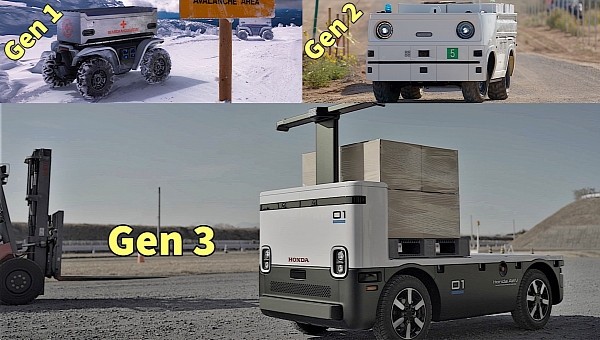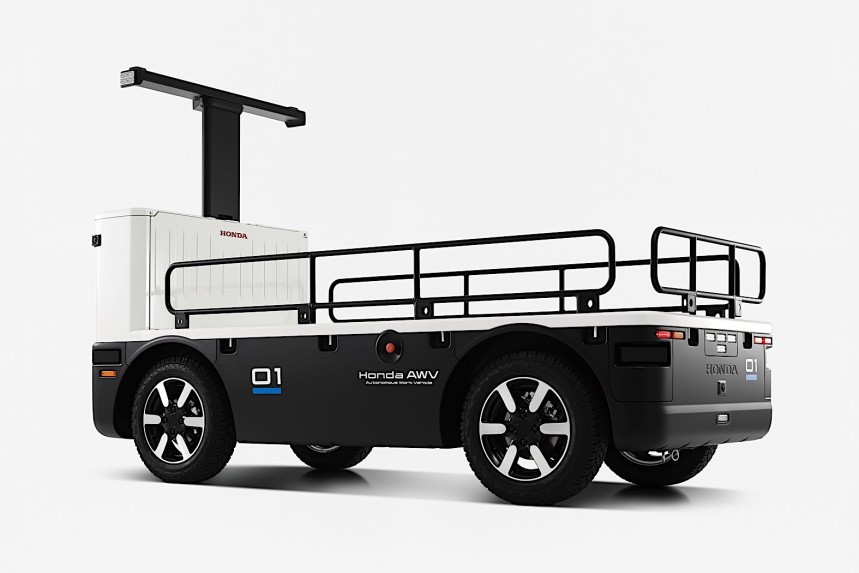Believe it or not, the cutesy contraption we’re here to look at is not new. Well, this particular vehicle is, but the concept of an autonomous machine for special duties has been in the works over at Japanese company Honda for a while now.
Back in 2018, Honda announced the start of something it calls the Autonomous Work Vehicle, or AWV. Back then the concept it presented was based on the company’s in-use ATV chassis, and it was meant as a tool to serve the needs of people working in construction and agriculture, but also firefighters and search and rescue services.
That AWV was to become the first generation in a line of prototype autonomous machines that are not yet in use but may forever change the way we do at least part of our daily jobs. The second one, a slightly larger and more capable contraption than the ATV-based AWV, entered testing phase in 2021, at one of the sites of U.S. engineering company Black & Veatch.
Next week the CONEXPO-CON/AGG 2023 construction trade opens its doors in Las Vegas, and it is there where Honda will show the world, in the flesh, the third generation of the prototype AWV. An evolution of the second one, brings more capabilities to the table, but still no projected roll-out date for the masses.
The new version is still cabin-less, only this time it received a stalk of sorts on its front end to accommodate at least part of the many sensors, radar, LiDAR, and cameras it needs to operate safely around construction zones.
Although it follows the same design ideas as the second generation, the new AWV does pack new features and capabilities, aside from the obvious stalk or the protection rails fitted around its bed.
First up, its carrying capabilities have been increased, so now the bed is large enough to accommodate two pallets. Consequently, the loading capacity has increased from about 900 pounds (408 kg) to 2,000 pounds (907 kg).
Then, the battery is slightly bigger, and it now sits at 18.6kWh. It's a small change, but one that makes the AWV able to move its cargo for distances of up to 28 miles (45 km). Not too shabby for a construction machine, but keep in mind that’s a variable number, as it depends on a lot of factors, from the type of terrain in travels to the weight of the cargo and the way it is run. The machine can run around doing its job for up to ten hours.
The top speed this thing can reach is 10 mph (that’s 16 kph, and you rarely need more than that on a construction site) - but that can only be achieved in autonomous mode. The vehicle can be operated remotely as well if need be, but when that happens the speed drops to just 2.5 mph (4 kph, just perfect for squeezing into tight spots).
As per Honda, the contraption is capable of operating even in areas where GPS is not available, is fully programmable, and has the ability to connect to a cloud.
Aside from letting us know the third-gen AWV is coming to Las Vegas for some meet-and-greet, Honda does not say what its plans for this particular machine are. And although it doesn’t officially say that, commercial availability of the vehicle is probably still many years away.
That AWV was to become the first generation in a line of prototype autonomous machines that are not yet in use but may forever change the way we do at least part of our daily jobs. The second one, a slightly larger and more capable contraption than the ATV-based AWV, entered testing phase in 2021, at one of the sites of U.S. engineering company Black & Veatch.
Next week the CONEXPO-CON/AGG 2023 construction trade opens its doors in Las Vegas, and it is there where Honda will show the world, in the flesh, the third generation of the prototype AWV. An evolution of the second one, brings more capabilities to the table, but still no projected roll-out date for the masses.
The new version is still cabin-less, only this time it received a stalk of sorts on its front end to accommodate at least part of the many sensors, radar, LiDAR, and cameras it needs to operate safely around construction zones.
First up, its carrying capabilities have been increased, so now the bed is large enough to accommodate two pallets. Consequently, the loading capacity has increased from about 900 pounds (408 kg) to 2,000 pounds (907 kg).
Then, the battery is slightly bigger, and it now sits at 18.6kWh. It's a small change, but one that makes the AWV able to move its cargo for distances of up to 28 miles (45 km). Not too shabby for a construction machine, but keep in mind that’s a variable number, as it depends on a lot of factors, from the type of terrain in travels to the weight of the cargo and the way it is run. The machine can run around doing its job for up to ten hours.
The top speed this thing can reach is 10 mph (that’s 16 kph, and you rarely need more than that on a construction site) - but that can only be achieved in autonomous mode. The vehicle can be operated remotely as well if need be, but when that happens the speed drops to just 2.5 mph (4 kph, just perfect for squeezing into tight spots).
As per Honda, the contraption is capable of operating even in areas where GPS is not available, is fully programmable, and has the ability to connect to a cloud.
Aside from letting us know the third-gen AWV is coming to Las Vegas for some meet-and-greet, Honda does not say what its plans for this particular machine are. And although it doesn’t officially say that, commercial availability of the vehicle is probably still many years away.













